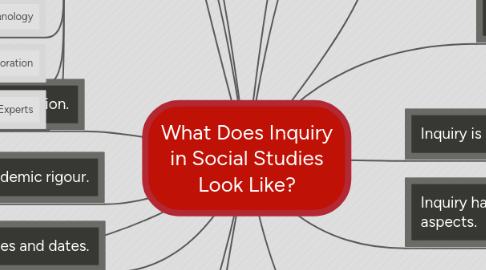What Does Inquiry in Social Studies Look Like?
by Sarah Adomako-Ansah


1. A good teacher ...
1.1. ...has students who show sophistication in their work
1.2. ... has students who are willing to complete tasks to the best of their ability.
2. Making a connection.
2.1. Between what you love to do with how you teach.
2.2. Shows your true passion.
3. Galileo's Nine Elements of Inquiry.
3.1. 1. Authenticity.
3.2. 2. Academic Rigour
3.3. 3. Assessment
3.4. 4. Life Skills
3.5. 5. Elaborated Communication
3.6. 6. Compassion
3.7. 7. Appropriate Use of Technology
3.8. 8. Active Exploration
3.9. 9. Connecting with Experts
4. NOT just about names and dates.
4.1. More about bringing kids into subjects that WE as teachers deem interesting.
5. Quote on academic rigour.
5.1. "Being in the company of a passionate adult who is rigorously pursuing inquiry in the area of their subject matter and is inviting students along as peers in the adult discourse."
6. Being MINDFUL OF GLOBAL EVENTS.
6.1. Not only the events happening in your city or country, but worldwide.
7. Encompassing many threads of study.
7.1. ie.) Sociology, psychology, politics, etc.
8. Critical Thinking.
8.1. Determine perspective.
8.2. Eliminate bias.
8.3. Weigh evidence.
9. Historical Thinking.
9.1. Historical significance.
9.2. Identify continuity and change.
9.3. Understand ethical dimensions.
9.4. Take historical perspectives.
10. Dangerous Teaching.
10.1. Refers to teaching that engages students in questions like, 'what?' and 'how?'
10.2. Offers to challenge society.
11. Inquiry is students engaging themselves.
11.1. Into the real world .
11.2. Making human connections.
12. Inquiry has to do with three main aspects.
12.1. How you teach.
12.1.1. New node
12.2. How you listen.
12.2.1. New node
